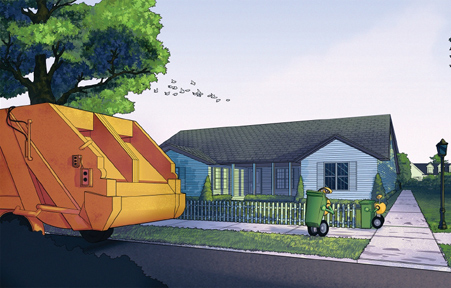A new way to handle garbage
 No
one likes to handle waste or garbage. That is human nature. But someone
has to collect garbage and empty it into a tractor, truck or compactor.
So far, this is being done by garbage collectors some of whom wear
gloves. If a team of international researchers succeed in their efforts,
robots could soon be doing this menial and unenviable work. No
one likes to handle waste or garbage. That is human nature. But someone
has to collect garbage and empty it into a tractor, truck or compactor.
So far, this is being done by garbage collectors some of whom wear
gloves. If a team of international researchers succeed in their efforts,
robots could soon be doing this menial and unenviable work.
The Volvo Group is currently working on a joint venture together with
Chalmers University of Technology and Mälardalen University in Sweden,
Penn State University in the United States, and the waste recycling
company Renova, to develop a robot that interacts with the refuse truck
and its driver to accomplish the work.
Network
The three universities are part of Volvo Group's Academic Partner
Program, a network of twelve academic partners collaborating with Volvo
for long-term cooperation in research and recruitment. The students have
different tasks and roles. Mälardalens University will design the robot
itself. At Chalmers University, students will work on the overall
operating system. At Penn State´s Thomas D. Larson Pennsylvania
Transportation Institute the graphics, communication systems and control
panel for the truck driver will be developed. The project is called
ROAR, for Robot-based Autonomous Refuse handling, and the goal is to
introduce a robot that, with the help of instructions from a truck's
operating system, can collect refuse bins in a neighbourhood, bring them
to a refuse truck and empty them. All of this occurs under the
supervision of the refuse truck's driver.
In cases where more personnel are separately employed to collect the
garbage, the robots will make them redundant since only the driver is
needed for this operation. This work will continue until June 2016, when
the technology will be tested on a refuse collection vehicle developed
by Renova and Volvo.
Sleeping
As the news release from Swedish truck maker Volvo puts it: "Imagine
a robot that quietly and discreetly enters your neighbourhood, collects
your refuse bin and empties it into the refuse truck. It is done without
waking the sleeping families and without heavy lifting for the refuse
truck's driver. This is the purpose of ROAR, a joint project with the
aim to develop tomorrow's smart transport solutions."
|

Automated refuse collection.
Pic courtesy: Volvo.com |
Volvo envisions this venture as just one manifestation of "a future
with more automation," according to project leader Per-Lage Götvall, who
also says that it will provide "a way to stretch the imagination and
test new concepts to shape transport solutions for tomorrow."
The purpose of ROAR is also to demonstrate how we, in the very near
future, will use smart machines to assist with a broad range of
activities in society. This technology can be applied in many areas.
Automated refuse collection is just one example.
Restricted
There are many advantages of this robotic project. Robots will never
get tired or sleepy, so they can work any time of the day or night.
Again, their 'working hours' will be restricted only by the ability of
the human driver to keep up. They do not have to be paid at all. They
will be able to work in any environment, rain or shine, and to work with
hazardous materials too. They will not mind the stench. They will not
(hopefully) miss a single address on the route. Eventually, they will be
able to tell the difference between food waste, plastics, metals etc
through a colour coding scheme.
On the other hand, the project is a very challenging one because
refuse collection is still seen as a labour intensive job and human
handlers may not like to give up their jobs to robots. Some drivers may
also detest the fact that they have to work alone with a bunch of
robots. House owners in turn may bemoan the lack of human interaction -
it is easy to complain or raise your concerns to a human garbage
handler, rather than to a mechanical robot.
Municipal authorities the world over will continue to study Volvo's
project in earnest and several other developments now underway ideally
complement its efforts. For instance, Cisco reports that Cincinnati
reduced residential waste by 17 percent, and recycling volume swelled by
49 percent with real-time data about the waste stream.
Autonomous
Researchers are also developing garbage receptacles that can
immediately notify herbage vehicle operators when they are full. At some
point in the future, the garbage truck itself could be autonomous,
leading to a three way communication network among the truck,
sensor-equipped bins and the garbage collecting robot. They will be able
to do their respective jobs with little or no human intervention.
Households will be able to monitor the process via their smartphones
and even schedule a pick up at another time. A US waste company has
already announced plans to launch a smartphone app that allows users to
call for a rubbish collection, the same way they might schedule a taxi.
Moreover, the garbage truck can be powered by electric batteries,
turbine or hydrogen fuel cells, which will minimize pollution. A trash
truck burns 14,000 gallons of fuel annually - 60 percent of which could
be saved with an electric battery power solution or an electric turbine.
In fact, Tesla co-founder and CEO of Wrightspeed Inc Ian Wright is
already testing an 80-kilowatt generator with a 10,000-hour life
especially built for trash trucks.
Robots are ideally suited to handle tasks that are either too
dangerous or too revolting for us, from demining to taking the trash.
Vacuuming robots such as Roomba are already available in the market. You
can buy 10 normal manually operated vacuum cleaners for around the same
amount of money, but no manual vacuum cleaner can beat the sheer
spectacle of a robotic vacuum cleaner going around a room on its own,
cleaning up and even recharging without any human intervention.
They will become cheaper in the next five years or so. Household
robots (which may or may not look like humans) will be commonplace in
around 20 years if present trends continue. These are exciting
technologies that can create a difference in our everyday lives in the
near future. |

